08 Sep Use of natural antioxidants to prevent woody breast in broiler chickens
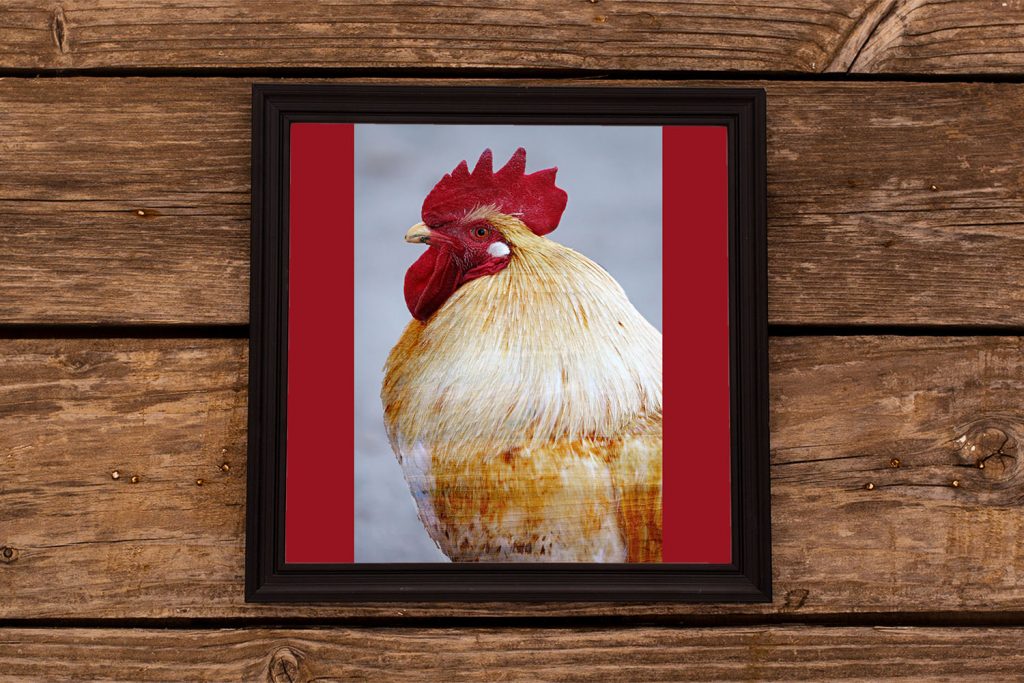
Producing high quality meat is a primary goal of the poultry industry. In the recent years, as chicken breeds are genetically selected for faster growth and larger breast meat, there has been an increase of myopathies (diseases of the muscle in which the muscle fibers do not function properly) mainly affecting the breast. The most frequent myopathies are white striping (white lines of fat tissue running through the breast meat) and woody breast.
Woody breast is a myopathy that is characterized by the breast meat being hard to the touch. This hardness can be present already in the live bird, as early as few weeks old, and can be detected by palpation. In the slaughterhouse, breast meat is scored using a rating system based on severity from 0 (no indication of woody breast) to 3 (severe).
Woody breast does not harm the animals and their meat is healthy to eat, but it affects their marketability. Compared to normal breasts, woody breasts:
- Have unpleasant texture and mouth feel
- The muscles are rigid and show a viscous exudate on the surface
- Lose more water before and during cooking
- Have a higher pH after slaughter
- Are less tender (higher shear force) before and after cooking
For all the above, woody breasts are unappealing, cannot be marketed to consume directly and are usually destined to produce ground meat.
It is estimated that 5-10% of the breast fillets produced worldwide show mild or severe woody breast conditions. Such a high incidence also increases the costs at the slaughterhouse, that needs to check the hardness of the breasts of each carcass after defeathering.
Metabolic consequences of woody breast
Broilers with high growth rate, feed efficiency and breast muscle yield are more prone to woody breast, because the muscle tissues grow disproportionally big and their normal metabolism cannot be properly supported by the connective tissue and the circulatory system.
During the woody breast syndrome, the metabolism and the structure of the muscle changes:
- The muscular fibers lose their normal structure and become larger
- The deposition of collagen and fats increases
- There is an infiltration of immune cells involved in muscle repair
- The blood flow in the breast muscle is reduced, making it difficult to supply oxygen and nutrients. Metabolic waste accumulates in the tissue.
As a result of the above, there is an increase of the concentration of free radicals, mainly reactive oxygen species (ROS), that produces oxidative stress in the muscular tissue. ROS start inflammation and induce changes in the muscle cells that ultimately lead to woody breast.
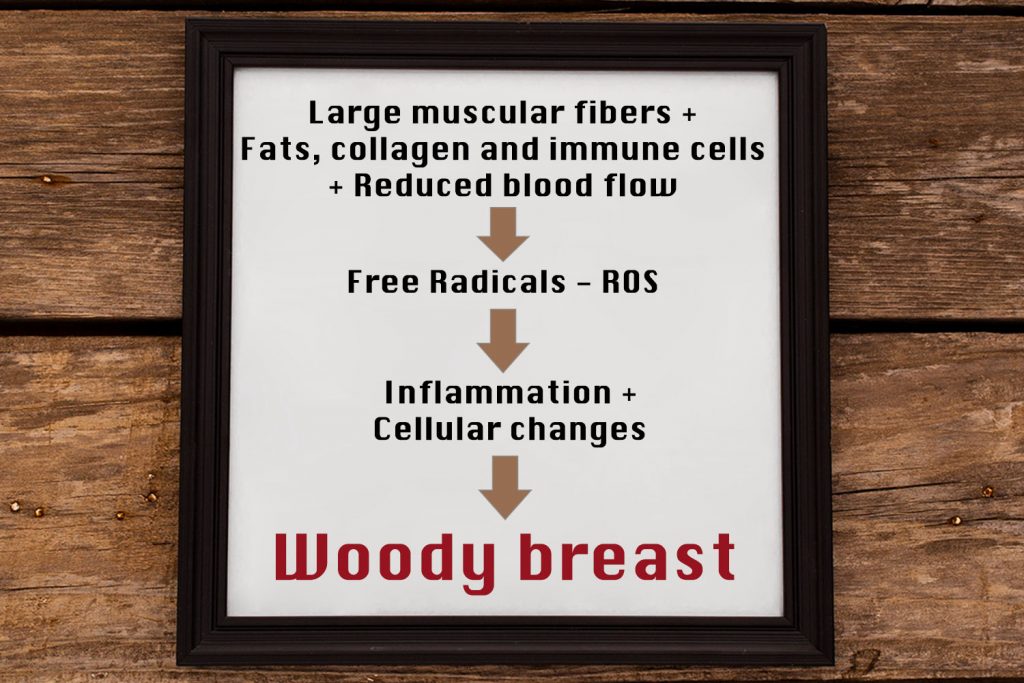
Use of natural antioxidants to prevent woody breast
Animals have developed their own antioxidant defense system to fight with free radicals. This system includes the presence in the body of fat-soluble antioxidants (vitamins A, E, carotenoids, etc), water soluble antioxidants (ascorbic acid, uric acid, taurine, etc.), antioxidant enzymes and redox systems.
The antioxidant defense system prevents the damages caused by free radicals. Dietary supplementation with antioxidants is a way to improve its efficiency.
Synthetic antioxidants such as BHA and BHA have been long used in feeds and foods to prevent oxidation, but their potential toxicity and increasing customer awareness has started a research for natural alternatives.
Natural antioxidants extracted from plants, including essential oils, contain powerful antioxidant molecules, mainly phenylpropanoids, phenols, polyphenols and carotenoids. Compared to synthetic antioxidants, some natural antioxidants show a greater antioxidant capacity. Besides, usually natural antioxidants exhibit a wide range of biological effects, such as microbiocide, antiinflamatory or immune boosting actions, positively affecting animal health and productivity.
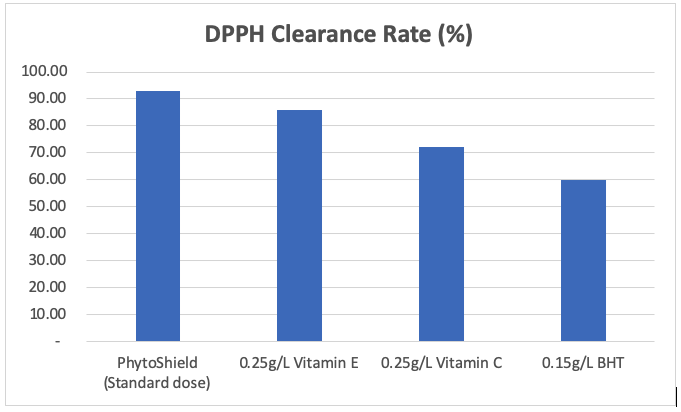
Antioxidant capacity of natural antioxidants
DPPH tests assesses the capacity of antioxidants to neutralize and clear free radicals.
Our product based on antioxidant essential oils, PhytoShield©, shows higher capacity than vitamin E, vitamin C and BHT.
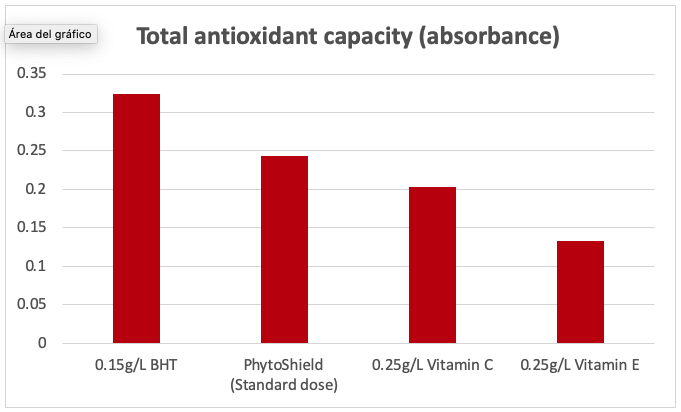
Antioxidant capacity of natural antioxidants
The total antioxidant capacity is a measure of both water-soluble and fat-soluble antioxidant molecules contained in the essential oils or plant extracts. This assay is based on the reduction of Mo(VI) to Mo(V) and the formation of the green phosphate/Mo(V) complex.
Our product based on antioxidant essential oils, PhytoShield©, shows higher capacity than vitamin C and vitamin E.
In the case of woody breast, administering high doses of antioxidants, especially during the grower and finisher stage of chickens, has been proven to reduce the onset of myopathies and the incidence of woody breast by 50%. Antioxidants work by:
- Eliminating oxygen-derived free radicals (ROS)
- Improving the resistance to metabolic stress and metabolic wastes
- Decreasing the synthesis of collagen
- Increasing vasodilation and blood flow
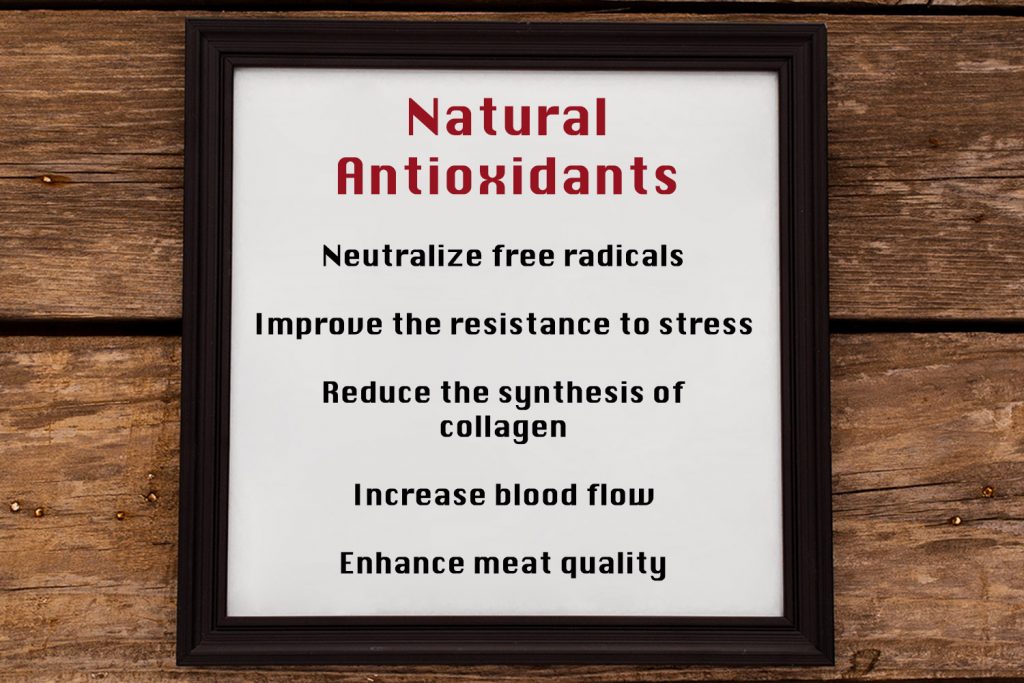
On the other hand, in a previous research we proved that the administration of the natural antioxidants contained in PhytoShield© improves certain meat characteristics also linked to woody breast, such as:
- Percentage of fat
- Water loss before and after cooking
- Tenderness
- Sensory qualities of the meat
Other tips to reduce the incidence of woody breast
- Reduce the amino acids in the diet to slow down growth
- Keep the birds within the standard growth curve and the recommended weight ranges
- Avoid environmental stressors and optimize ventilation
Photo by Sheri Hooley on Unsplash
Wooden frame Mock up found here.
Product of choice
PhytoShield© is an oral emulsion that contains essential oils, electrolytes and vitamins intended to promote growth, reduce oxidative stress, and keep the animals hydrated.

Certain health statements may not be applicable in your region.

